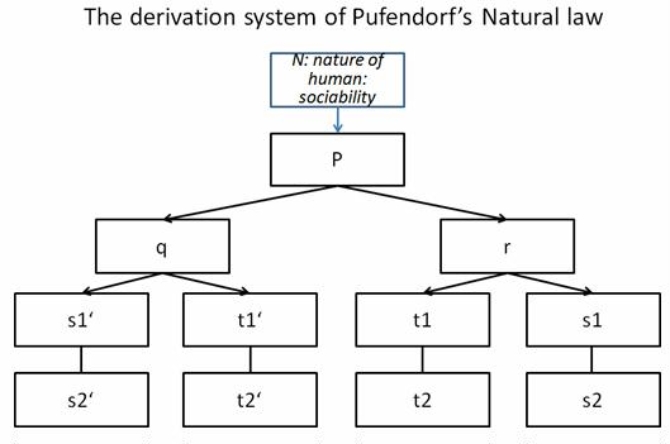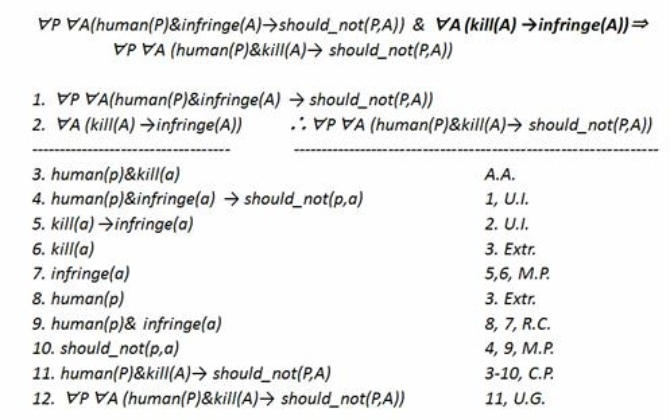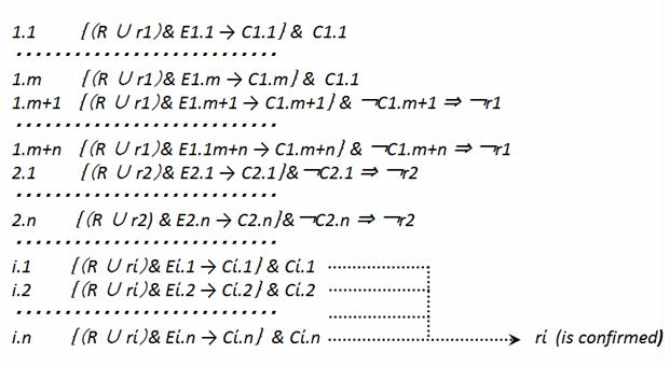1.
Introduction ^
2.
The applicability of classical logic to the reasoning of justice ^
As regards to the method of logic as a tool to analyze the reasoning of justice, we apply classical mathematical logic directly to the analysis of justice. In contrast, we do not apply a special logic of norms (e.g., deontic Logic).
The scholars who refrain from applying classical logic to legal norms stress the semantic nature of norms as their reason. Such a viewpoint is based on the following two assumptions and the inference resulting from them («Dilemma of J¢rgensen»)
- Norm-sentences cannot be described as true or false.
- The system of classical logic is based on the evaluation of sentences in respect of true or false.
- Classical logic, therefore, cannot be applied to norm-sentences.
The pessimistic view in regard to the applicability of classical logic to norm-sentences results from a misunderstanding of the concept of truth in logic which is not identical with the normal epistemological truth-concept. Therefore, it is important to first review the truth-concept of logic before further discussion.3
Φ: a single-term predicate
i: an interpretation-functor
α1, ... , αn: individual constant or variable
(A) Φ(α1, ... , αn) is true under i if
(B) Φ(α1, ... , αn) is false under i if
3.
The placement of the concept of justice in logic ^
(a) It is just that all humans must be punished if they have killed another human.
(b) It is unjust that all humans must be praised if they have killed another human.
(a’) It is true that all iron expands if it is heated.
(b’) It is false that all iron contracts if it is heated.
(A’) Φ(α₁, … , αn) is just if and only if< i (α₁), … ,i (αn)>∈ i(Φ)
(B’) Φ(α₁, … , αn) is unjust if and only if< i (α₁), … ,i (αn)> ∉i(Φ)
(a’) It is just that all humans must be punished if they have killed another human.
(b’) It is unjust that all humans must be praised if they have killed another human.
4.
On Samuel Pufendorf’s systematization of just legal norms ^
He thought that this supreme, most general natural law contains all particular natural laws and the latter can be deduced from the former and be reduced to it.7 Thus, starting from this extremely general and abstract fundamental natural law principle (p), he derived:
(1)The natural law norm of humans’ action for himself (q) and (2) the natural law norm of humans’ action for other persons (r).8 From this natural law norm (r), he derived «absolute norms» (s), obligating all men and «hypothetical norms», depending on human’s judgment (t). These are more particular and concrete norms of natural law.
As the derivation of (s) from (p) through (q), he derived: «I. No one should hurt another (s1’) and II. If he has caused another a loss, he should make it good (s2’).»9 As the derivation of (s) from (p) through (r), he derived the norm10: «If one has done another some hurt, (s1) … the aggressor must, as far as he can, make good the loss.» (s2)
«is a human»: human(p);
«infringe the human personality»: infringe(a);
«should not do a»: should_not(p,a);
«to kill human h»: kill(h), then the inference above is formalized as follows:
∀P∀A(human(P)&infringe(A)→should_not(P,A))⇒
∀P∀A(human(P)&kill(A)→should_not(P,A))
It can be proved that this inference formula is logically invalid because its antecedent is true and its consequence is false in the following interpreted case:
human(P):P>=3;
infringe(A): A=<3;
should_not(P,A): P>=A;
kill(A):A>=4.
This is the case when P=3 and A=4 as follows (Proof 1):(human(P) &infringe(A) ➙should_not(P,A))⇒(human(P)&kill(A) ➙should_not(P,A))
5.
The role of the deductive methods in the reasoning of justice ^
The reasoning of creation or discovery is composed of two further types of reasoning which are mutually related to each other:
generation of hypothetical just norms and
testing the hypothetical just norms.
The goal-oriented induction is the following:
goal: g(a),
fact: f(a)
generation: g(X)←f(X)
The abstraction-based induction is represented as follows:
concrete norms: g1(X)←f1(X), g2(X)←f2(X)
knowledge on concepts: g1⊂g, g2⊂g, f1⊂f, f2⊂f
abstraction: g(X)←f(X)
We think that Poppers falsification model does fit to the method of testing hypothetical just norms. The inference to test a hypothetical norm is Modus Tollens, which is represented in propositional logic as follows:
(P→ Q) &¬Q⇒¬P
«Q» represents the consequence which follows from the system to which the new hypothesis is added. If Q is negatively evaluated (falsified: ¬Q), then the system including the hypothetical norm is to be negatively evaluated (falsified: ¬P) as well.We would like to represent this inference scheme more precisely identifying the system of the already existing knowledge and the added hypothesis as follows. If «R» is the whole of the existing knowledge, «r» is a new hypothetical norm, «E» is an event to which the hypothesis is applied and «C» is the consequence of the application of the whole existing knowledge together with the hypothesis, then the inference scheme of the falsification of the added hypothesis is:
{(R ∪ r1)& E → C}&¬C ⇒¬r1
- The creative evaluation of a legal sentence in legal practice is done mostly not on the positive way to evaluate it as just but on the negative way to evaluate it as unjust. The reason is that it is difficult to verify that a legal sentence is just but easier to falsify that it is unjust15.
- It may also be the reason that law must provide a certain norm to solve social disputes and to maintain an order in a society so that legal norms provided should be treated as temporally just unless they are proved to be unjust.
6.
Conclusion – Future tasks ^
7.
Acknowledgement ^
Prof. Friedrich Lachmayer is one of my best friends since 1974. He has always kindly supported my study of Logical Jurisprudence. I thank Friedrich very much for his support. With many thanks I would like to dedicate this paper to Friedrich. Prof. Erich Schweighofer has kindly invited me to contribute to these proceedings and patiently encouraged me to complete my paper. I thank Erich a lot for his warm encouragements. This paper is completed during my stay in Kiel as a visiting professor of the «Lehrstuhl für Öffentliches Recht und Rechtsphilosphie der Christian-Albrechts-Universität zu Kiel (Prof. Robert Alexy)». I appreciate Robert’s warmest support. My student-assistants in Kiel Regina Kardel, Dennis Hardtke and Sven Petersen have assisted me well, whom I am grateful to. This paper was checked by Prof. Jackson Wilson. I appreciate Jackson’s review.
Hajime Yoshino, Meiji Gakuin University.
Some of the original ideas of this paper were presented in my Japanese paper «Seigi to Ronri – Seigi-Suiron niokeru Enekiteki Hoho no Yakuwari» (Justice and Logic – The role of deductive methods in the reasoning of justice), in: Justice – Annual Report of Legal Philosophy 1974, Yuhikau Publishing Tokyo, 38-68. In the meantime, I developed the theory of legal reasoning through the studies on the artificial intelligence of law. This paper has much expanded from the previous paper by including various results of study on the theory of legal reasoning. On May 24th, 2012 at University of Lisbon, I gave a lecture titled «Justice and Logic – the role of deductive methods in the reasoning of justice» at the Third International Conference on Quantitative Justice and Fairness 2012, organized by Prof. Paulo Mendes at University of Lisbon and Dr. Rainhard Bengez at Technical University Munich . This paper has been written on the basis of my power point presentation submitted to the conference.
- 1 Cf. Yoshino, Hajime, «Über die Notwendigkeit einer besonderen Normenlogik als Methode der juristischen Logik», in: Klug, U. et. al. (Hrsg.), Gesetzgebungstheorie, Juristische Logik, Zivil- und Prozessrecht, Berlin – Heidelberg – New York, Springer Verlag, 1978, 140 ff. Below, this is abbreviated as Yoshino, 1978a.
- 2 Some restrictions are desirable for us in order to realize computational efficiency of legal reasoning, for example to restrict predicate logic into horn-clause logic as its subset and presuppose the closed world assumption. Some extensions are desirable for us to represent legal relations as entities using identifiers and case lists of legal terms. See: Yoshino, Hajime, «On the Logical Foundation of Compound Predicate Formulae for Legal Knowledge Representation,» in: Artificial Intelligence and Law, Vol. 5, No. 1, 77–96; Yoshino, H. and Sakurai, S., «Identification of Implicit Legal Requirements with Legal Abstract Knowledge,» in: Proc. The Fourth International Conference on Artificial Intelligence and Law, ACM (The Association for Computing Machinery), 1993, 298 f.
- 3 This is necessary also to understand the starting point of Logical Jurisprudence, because the truth concept is one of three primitives of Logical Jurisprudence.
- 4 Weinberger, Ota, Bemerkungen zu J. Rödig’s «Kritik des normlogischen Schließens», in: Theory and Decision 3 (1973), 314.
- 5 Cf. Yoshino, 1978a, 145.
- 6 Pufendorf Samuel, De Jure Naturae et gentium libri octo, Amsterdam Aufl. 1688, 143 ff. The translation by Oldfather, 208 ff.
- 7 Cf. Pufendorf, S., Eris scandica, 1686, 231 f.; Denser, Horst, Moralphilosophie und Naturrecht bei Samuel Pufendorf, München 1972, 289; Welzel, H., Naturrechtslehre Samuel Pufendorfs, Berlin 1958, 51.
- 8 Pufendorf, S., De Jure Naturae et gentium libri octo, Amsterdam Aufl. 1688, 143 ff. The translation by Oldfather, 229, 313 f.
- 9 Pufendorf, S., ibid., (3I.1) 213; cf. Translation, 313.
- 10 Pufendorf, S., ibid., 314.
- 11 Pufendorf, S., ibid., 229 f.
- 12 Popper, K., The Logic of Scientific Discovery, Hutchinson of London, 1959, 30.
- 13 Popper, K., ibid., 40.
- 14 Popper, The Logic of Scientific Discovery, Hutchinson of London, 1959, 46.
- 15 Cf. Edmond Cahn, The Sense of Injustice. New York 1949, 11–27.














